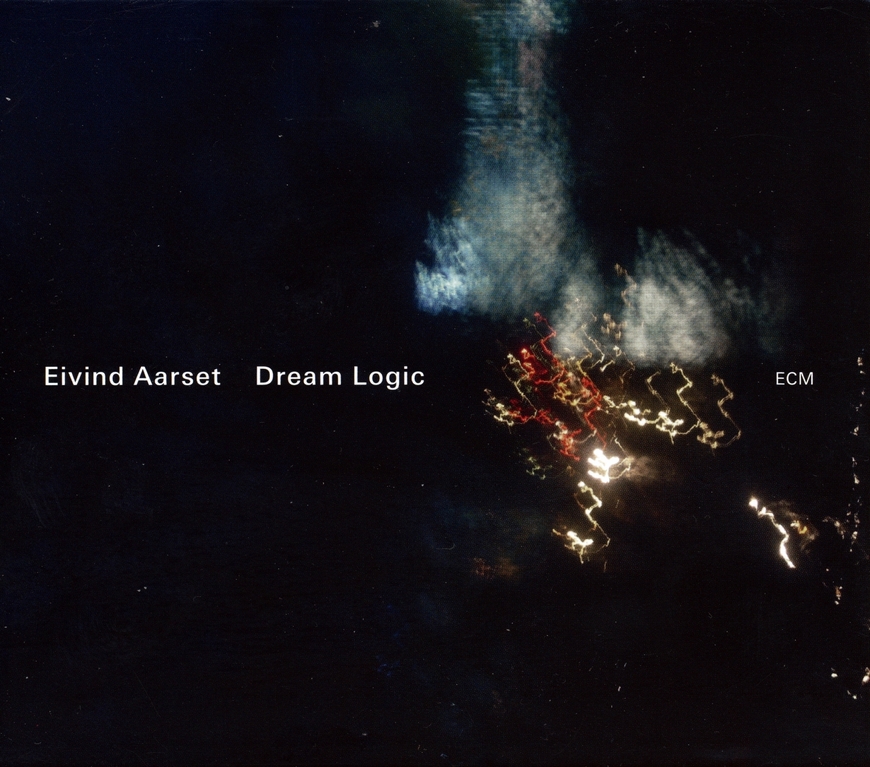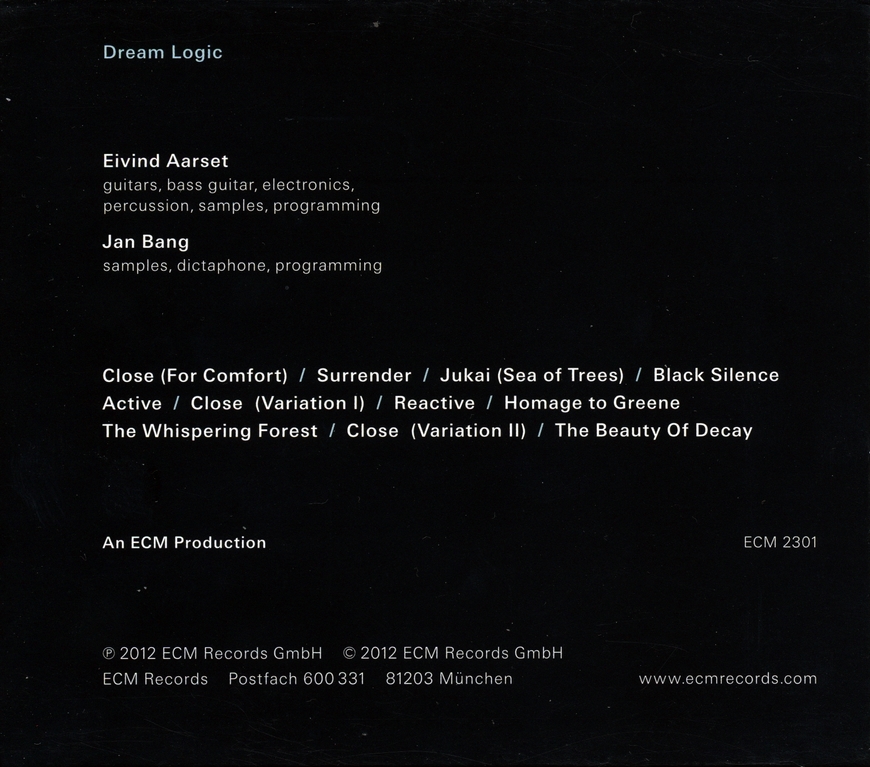


BOOKLET
Artists: EIVIND AARSET
Title: DREAM LOGIC
Released: November 2012
Recorded and mixed 2011/12 at Punkt Studio and Tjernsbråtan by Jan Bang, Erik Honoré, and Jan Erik Kongshaug
Mastering: Jan Erik Kongshaug, Rainbow Studio
Cover Photo: Russana Werbicki
Liner Photos: Soukizy, Luca Vitali, Karl-Heinz Schmitt
Design: Sascha Kleiss
Produced by Jan Bang
Genre: Avant-garde, Experimental, Electronic, Jazz
Length: 47:33
Label: ECM (23011)
***Tracks:
01. Close (For Comfort) 6:34
02. Surrender 4:21
03. Jukai (Sea Of Trees) 3:45
04. Black Silence 4:03
05. Active 3:20
06. Close (Variation I) 2:39
07. Reactive 2:21
08. Homage To Greene 5:29
09. The Whispering Forest 5:42
10. Close (Variation II) 1:43
11. The Beauty Of Decay 7:06
Total duration: 47:33
Musicians:
Eivind Aarset: guitars, bass guitar, electronics, percussion, samples, programming
Jan Bang: samples, dictaphone, programming
***Comment from http://www.ecmrecords.com/:
The renowned Norwegian guitarist – who has previously contributed to ECM recordings with Nils Petter Molvær, Marilyn Mazur, Arve Henriksen, Andy Sheppard, Arild Andersen and Jon Hassell – with a first ‘leader’ disc for the label, recorded in Kristiansand and Oslo. “Dream Logic” is aptly named, its slowly developing drifting pieces, built up from layers of guitars, have an almost hallucinatory quality, an otherworldly ambience. Jan Bang, who is co-composer of a number of the pieces, also contributes sounds and samples, and co-produced the disc.
Project:
Norwegian guitarist Eivind Aarset has contributed to a number of influential ECM recordings including Nils Petter Molvær’s “Khmer” and “Solid Ether”, Arve Henriksen’s “Cartography”, Andy Sheppard’s “Movements In Colour”, Arild Andersen’s “Elektra”, Jon Hassell’s “Last Night The Moon Came…” and Marilyn Mazur’s “Small Labyrinths”. The aptly-named “Dream Logic” is his first ‘leader’ disc for the label. With its drifting planes of sound-texture, built from layers of processed guitar, sometimes supported by subliminally-throbbing bass, and its otherworldly ambience, it attains an almost hallucinatory quality, underlined by its avoidance of stressed time. Rhythms are as liquid as Aarset’s phrasing. “Dream Logic” is an album of sound-painting which begins with guitar but goes beyond it, moving in mysterious waves. Jan Bang, who is co-composer of a number of the pieces, also contributes sounds and samples, and was the recording producer for sessions at Tjernsbråten, Punkt and Rainbow Studios, aided by frequent collaborator Erik Honoré.
In the pieces heard here, Aarset’s guitar is the starting point, with guitar lines, melodies and textures slowly opened up through the discreet use of samples and programming, developing and expanding the emotional core of the material. Transition points between guitar and electronics are blurred; one is an extension of the other. And Aarset has long since learned to make musical use of his pedals and effects boxes, applying delays and feedback to create a very singing line, ricocheting in a reverberant hall of mirrors to create a sense of deep space. Associations abound: the dark drones of the album’s longest piece, “The Beauty Of Decay”, for instance, might suggest affinities with Indian vocal music or perhaps with the world of the Indian-inspired Jon Hassell, whom Aarset has acknowledged as an important source.
Artists:
Like many guitarists of his generation Eivind Aarset (born 1961 in Drøbak, Norway) was first influenced by rock players, Jimi Hendrix above all. By the mid-1970s electric jazz caught his attention, especially Miles Davis’s “Agharta” album with the fiercely-distorted lead guitar of Pete Cosey raging around Miles electric trumpet. Aarset was also listening to ECM’s early albums, especially those of Terje Rypdal and Jan Garbarek.
After a period on the road as a heavy rock guitarist, Aarset worked prolifically as a session player, appearing on more than 150 albums in this capacity for both Norwegian and international productions. It was on the session circuit that he first encountered Bugge Wesseltoft and Nils Petter Molvær. In 1997, Molvær and Aarset joined Marilyn Mazur’s band, and recorded “Small Labyrinths” for ECM.
The bigger news that year, however, was the release of “Khmer”, Molvær’s genre-changing album, which featured plenty of Eivind’s exploratory guitar, now weaving its way between free-running samples, programmed beats and turntable scratching. Inside the Molvær band, Aarset had plenty of freedom to develop his textural guitar playing, further showcased on his own discs on Wesseltoft’s Jazzland label including “Électronique Noir”, “Connected”, “Sonic Codex” and “Live Extracts”.
Eivind Aarset can also be heard on “Mercurial Balm” the new album by Food, the improvising project of drummer Thomas Strønen and saxophonist Iain Ballamy, released in November in Europe and early 2013 in the US.
***Review from http://www.independent.co.uk/:
Album: Eivind Aarset, Dream Logic (ECM)
4 stars out 5
Phil Johnson, Sunday 18 November 2012
Not really “jazz” as such … Aarset is a Norwegian guitarist and ECM stalwart and Dream Logic entails much of what its title promises: space, abstraction and very little regulated rhythm.
Instead, the principal and his accomplice, programmer Jan Bang, set about their themes with an ambient-music mindset, more attuned to stillness than movement. “Close”, “Black Silence”, “Surrender”, “The Beauty of Decay”… Well, you get the picture. It is sometimes beautiful.
***Review from http://ecmreviews.com/:
Eivind Aarset: Dream Logic (ECM 2301)
Posted on October 28, 2012
Eivind Aarset
Dream Logic
Eivind Aarset guitars, bass guitar, electronics, percussion, samples, programming
Jan Bang samples, dictaphone, programming
Recorded and mixed 2011/12 at Punkt Studio and Tjernsbråtan by Jan Bang, Erik Honoré, and Jan Erik Kongshaug
Mastering: Jan Erik Kongshaug, Rainbow Studio
Produced by Jan Bang
Eivind Aarset, without whom Nils Petter Molvær’s breakthrough Khmer might never have reached its full potential, gets an ECM space of his own at last. As much a child of the label as he is of Jimi Hendrix and Miles Davis, the Norwegian guitarist brings attunement to every touch of the strings. Into the synchronicity of technique and vision he has sculpted since his early teens, Aarset has absorbed inspiration from a variety of musicians, including Bill Laswell, Marilyn Mazur, and, above all, Jon Hassell. That said collaborators are all masters at creating dream logics of their own is no coincidence, for he too is the student of another time-space continuum. With guitar as writing instrument and an array of electronics as his paper, he takes down field notes of a culture we’ve never known, a culture that slides down the ladders of our DNA and airbrushes mantras onto our microbes. Partner Jan Bang—who worked alongside Aarset most recently on Hassell’s Last night the moon came dropping its clothes in the street—adds rivers and landmarks, making the overall effect that much more immediate. Given the above history, one would expect long dronescapes, à la Re: ECM, to prevail. What we get instead is a set of eleven glimpses averaging four minutes apiece. These are no scale models, but self-aware biomes along whose ghostly borders flourish colonies of samples and contact wire.
In spite of the technological array in which it finds itself, the guitar of Dream Logic is naked as can be. The ensuing digital offshoots, as much reflections of the instrument as they are of it, are elementally no different than steam and water: only their physics has changed. Thus, the spidery crawl space of “Close (For Comfort)” feels less like an introduction and more the extension of life cycles as yet unheard. Its throats sing to us in two further variations, each slightly more corroded than the last. Contrast this with the texture of “Surrender,” which with its amniotic undercurrents gives no indication of flaw.
As the credits inform us, koto virtuoso Michiyo Yagi gave “Jukai (Sea Of Trees)” its title, an evocative one that carries the same double meaning in Japanese (樹海) as it does in English. Here, Aarset opts for the literal, painting with underwater gamelan a forest of internality. The level of development in its few short minutes is astounding, indicative of the thought put into the album as a whole. A subterranean bass tickles the soles of our feet in “Black Silence,” where slumbers a leviathan prayer. Its pizzicato veins chart every contour of our spines in “Active” and “Reactive” before spreading into the viscous pulchritude of “Homage To Greene.” Through a Taylor Deupree-like veil, Aarset weaves threads of guitar in a swaying rhythmic tide. If the foliage of “Jukai” could speak, it might sound like “The Whispering Forest,” which opens itself to concretely melodic shapes. Of the drone, we get only a teaser in “The Beauty Of Decay.” In the same way that the beginning was an end, so is this end a beginning. With a methodical sweep of the minute hand, it resets us to local time, that we might take this slow plunge into jet lag once again.
(To hear samples of Dream Logic, click here)
***Review from http://www.allmusic.com/:
by Thom Jurek
4 stars out 5
Dream Logic may be guitarist Eivind Aarset’s debut album as a leader for ECM, but his résumé with them is abundant. He has appeared on recordings led by Arild Andersen, Andy Sheppard, Marilyn Mazur, Nils Petter Molvaer, Jon Hassell, and Arve Henriksen. Aarset has never been intereseted in drawing attention to himself, only to what he is performing, which explains, in part, his appeal to such a wide array of musicians. Dream Logic, produced by electronic conceptualist Jan Bang, provides ample evidence of Aarset’s ability to define his path, while disappearing into it. He and Bang played, programmed, and sampled everything here. What these 11 pieces all have in common is that they use the guitar as a starting point for exploring, yet all but unmake its recognizable sound in pursuit of sound itself. Dream Logic is an “ambient” album, but also a musically courageous one. Its dynamics are restrained; deep consideration is given to space, silence, and an uncluttered sonic presentation, yet contains a wealth of improvisation. Its palpable warmth makes it feel more at home with Hassell’s ’80s recordings for EG than the icy clarity of vintage ECM. “Surrender,” with its nocturnal drift, is a perfect illustration. The guitars are muted as single strings make their way out of a washed-out backdrop. A bass plays a recognizable, repetitive pattern and melody asserts itself almost absentmindedly as a snare loop accents the end of each line. Aarset plucks strings from the ether, using the guitar’s bridge as a tonal signifier for his shimmering acoustic and electric chords. On “Black Silence,” the primary instrument is space itself. Halting waves of indeterminate sounds assert themselves every 15 or 20 seconds, while string scrapes, plucks of muted strings, and heavily treated bass chords underscore various electronic processes. The implied sense of foreboding is broken occasionally when a flute sample floats to the surface implying a melody. Were it not for Bang’s electronic textures, “Reactive” might have passed for an improvisation by Derek Bailey. Just when that comparison becomes almost too apt, Aarset asserts colorful chords into the mix. “Homage to Greene” references Fleetwood Mac guitarist Peter Green. Its plotted chord progression and use of reverb and lyricism, extends the exotic reach of its subject’s composition “Albatross” into the 21st century. Set closer “The Beauty of Decay” wanders along the horizon of a single chord, exploring individual notes, textural possibilities, spaces and silences, as guitars and basses, skeletally programmed percussion, and samples and random sonics emerge, entwine, and separate, creating a pulse that governs a labyrinthine melody that is as beautiful as it is haunting. Dream Logic evidences Aarset as an extremely adventurous sonic explorer while simultaneously subtly expressing his considerable gift as an improving guitarist.
